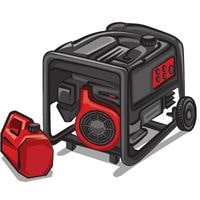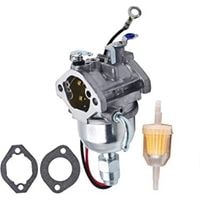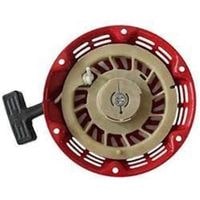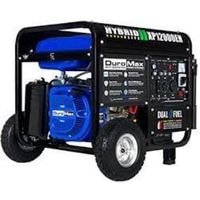Why Won’t My generator Start. Starting your generator shouldn’t be hard. Most of us know how to do it. Sometimes we might not see it or not see the signs, but if your generator won’t start there are a number of problems that can happen.
Usually, I’ve noticed that people don’t know what’s wrong with their generators because they too often just follow the one way they learned how to start them.
Why Won’t My generator Start
Why Won’t My generator Start? If the carburetor clogs, there’s a good chance that the fuel nozzle or hose is clogged as well.
If you can’t get your generator to kick on properly, check and see if gasoline is freely flowing through the line from the fuel valve to the carburetor.
Be sure to have a bucket handy for catching excess gas when you do that.
Also, check for any blockages in the filter between the fuel valve and carburetor to resolve your issue as quickly and efficiently as possible.
Electricity Failure
Several electrical components in modern generators are prone to failure. It’s important to check that the on/off switch, low oil protection switch, and electric starter are in good working order, so be sure to use a multimeter to test for continuity.
Faulty switches should be replaced, which is a job best suited for an electrician. Make sure that you don’t “bridge” over faulty wiring. This means attempting to jump across the circuit with your own wire in order to bypass the faulty piece.
You should also ensure that you replace any corroded wires or terminals with new ones made of the same gauge as what was originally there.
Carburetor Clogged
Before you attempt to start your generator again, a few things need to be done to ensure that it runs smoothly. You can drain gasoline from the carburetor by closing the fuel valve using a hook attached to a T-handle.
Make sure you have enough towels and brushes on hand so they can soak up any excess gasoline while you’re working with this step.
It’s also useful to have an extra bowl or container separate from the main one that can catch any gas that is leaking out of this area before cleaning it up with rags or paper towels.
In order to clean the brass jets in your generator, use a needle or straight pin and insert it into each fuel nozzle hole and move around gently without applying too much pressure.
Spark Plug Problem
Inspect the spark plug for signs of wear. Look to see if the porcelain insulator shows signs of cracks or is missing pieces if it looks like the ground electrode is damaged (ground electrodes should look round).
Make sure there isn’t a large buildup of carbon (that means the engine might be misfiring). You can use a tester to find out if this is, in fact, the case. If it’s not giving off enough power – replace it with a new one.
Defective Flywheel Key
The flywheel key might have snapped in half. The flywheel key is a small metal piece that fits into the harmonic balancer and engages with the flywheel.
If the engine stops suddenly, the flywheel key may break in half. To determine if the flywheel key is broken, remove the harmonic balancer from the engine and inspect the flywheel key.
If there is any cracking or chipping around its edges and it smells burnt, replace it with a new one.
Faulty Recoil Starter
The recoil starter assembly serves to engage the crankshaft, ensuring that the engine starts. If it isn’t engaging properly, then you might need to try adjusting some of its settings.
Remove the assembly and inspect it carefully, checking to make sure all its settings are fine and in place if you suspect there’s something faulty with it.
When working correctly, you should be able to observe an appropriate amount of ‘play’ in the rope as well as tabs extending from one component’s pulley and cam hooking onto one of the other component’s hooks, causing your engine to start when pulled back. When released, these tabs will retract, allowing for this action to happen all over again.
Ignition Coil Issue
The ignition coil is responsible for sending voltage to the spark plug. If the ignition coil does not send voltage to the spark plug, then starting an engine may be difficult.
As mentioned above, ensure that the spark plug of your vehicle is working properly before proceeding to inspect the ignition coil.
Using an ignition detail tester on an ignition coil fitted in your vehicle will help you determine whether there are any problems with it. Commonly, if problems are apparent, it’s recommended that you just replace the faulty part – in our case, the ignition coil.
Low Fuel Tank
When starting up a generator, make sure to check its fuel levels and refuel if needed. You should also ensure that the valves and tubing connecting the gas tank are opened.
As well as removing any dangerously old gas left inside the generator or its fuel line be careful replacing it with new gasoline because while in theory adding fresh fuel is fine.
Any gas over two months old could still damage your device proof of this is how even once the generator has run out of gas, if you don’t add any more than two months later, the problem starts again.
Choke Control Malfunction
The choke regulates the amount of air entering a carburetor at the beginning of motor use. If an engine doesn’t start right away, it may be because there is not enough air mixing with fuel to start it.
A very cold motor should have its choke closed completely, as well as a hot motor that runs well once it warms up. If a warm or already running motor still isn’t running well, slide the choke halfway open while you try to restart it.
Why Won’t My generator Start
Related Guides
